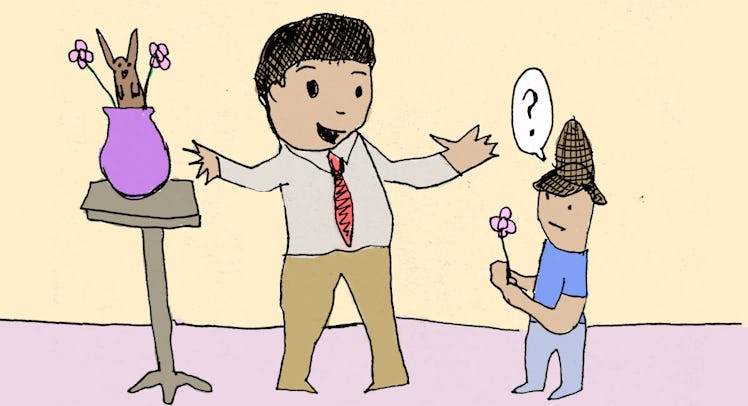How to Entertain Kids With The “Detective” Game
Not only does it stretch your kids’ brains a bit, but also their bodies as they excitedly run around the house or yard.

‘Detective’ is a game in which you hide something special around the house, and then leave a chain of clues for your kids to find and solve until they uncover the hidden prize. It’s easier than it sounds to set up and can be played with a few pieces of scratch paper or some common household items. It’s a killer way to entertain kids on stormy days and, even better, if the weather is nice you can expand the adventure outside or to a park with a little foresight. And not only does it stretch your kids’ brains a bit, but also their bodies as they excitedly run around the house or yard. For my money, it’s one of the greatest rainy day activities for kids there is.
Prep Time: 15 minutes
Hours of Entertainment: About 30 minutesEnergy Expended by Child: Physical and mental, loads of each
What You Need:
- Something to hide. Literally, anything. That said, the game works better if the item has either sentimental value or can be eaten.
- A series of clues. These can take almost any shape or form ⏤ either actual objects that point to another part of the house or a piece of paper with a riddle, question, or other written message. The important thing is that they should be understandable to a child and small enough to be hidden.
- Props. These aren’t required, but what kid detective wouldn’t want a fake magnifying glass or Sherlock Holmes hat?
How To Play:
Start with the premise of your mystery: Something is missing or has been stolen. It could be a favorite toy, stuffed animal, or even a piece of candy your kids can devour in the end as a reward for solving the case. If you want to throw a bad guy into the premise, by all means, do so ⏤ more storytelling is always good.
Now, with the kids in another room and the door closed, select and hide the clues. Ideally, you’ll have prepared these ahead of time, but if they’re pre-occupied building a block tower or something, it’s easy to come up with a handful of clues on the fly and scatter them about the house. Obviously, again, the clues must daisy-chain until the final one reveals the location of the hidden treasure. Also, don’t hide them somewhere where they’ll be discovered by mistake.
With clues hidden and the kids eager to reveal who killed Professor Plum, you start the story: “Oh no, Mr. Buttons has gone missing, where could he have gone? What’s this? A LEGO block?” And so the game begins by picking up your first clue, the block. This discovery leads your kids to the LEGO box, which has a fork in it. The fork, of course, points them in the direction of the cutlery drawer, which has toilet paper in it. The paper takes them to the toilet paper roll in the bathroom, which has a crayon in it. The crayon leads them to the pencil case where they keep their crayons, which, low and behold, is now full of Cheerios. You get the idea. They end up in the cupboard where, after taking a break to eat cereal, uncover a rubber ball. And so on, and so on, and so on.
The length of your goose chase is entirely dependent on how many clues you hide but will be filled with giggles no matter how many (or few) there are. Obviously, for more exhausted children by the end of the game ⏤ hide more clues.
The best part of ‘Detective,’ however, is that it can be different every round. One time you can hide pieces of a note, ripped up like a puzzle, which when compiled can lead to something else. Another version could include a series of boxes, each with a different key inside. Kids love keys. And yet another could be pirate-themed with a map highlighting different landmarks around the house. The flavor can change but the basic game stays the same.
Wrap Up:
The ‘Detective’ game is great for burning energy and working your kid’s brain and imagination. The more ridiculous the clues, the better. Depending on their age, kids may need the occasional hint every now and then, but that’s all part of the fun. Solving the case will give them such a feeling of satisfaction that you might just find them creating their own mysteries to solve.
